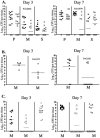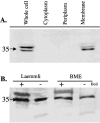Characterization of a novel porin involved in systemic Yersinia enterocolitica infection
- PMID: 16790812
- PMCID: PMC1489722
- DOI: 10.1128/IAI.00154-06
Characterization of a novel porin involved in systemic Yersinia enterocolitica infection
Abstract
Yersinia enterocolitica is an enteric pathogen capable of causing systemic disease in a murine model. We have identified a novel protein, systemic factor protein A (SfpA), conserved in other pathogenic bacteria that is involved in systemic disease. Analysis of bacterial colonization revealed that a DeltasfpA strain is defective in mesenteric lymph node colonization. Bioinformatics and functional studies suggest that SfpA is a porin.
Figures




Similar articles
-
Murine neonates are highly resistant to Yersinia enterocolitica following orogastric exposure.Infect Immun. 2007 May;75(5):2234-43. doi: 10.1128/IAI.01681-06. Epub 2007 Feb 26. Infect Immun. 2007. PMID: 17325052 Free PMC article.
-
A simple adult-mouse test for tissue invasiveness in Yersinia enterocolitica strains of low experimental virulence.J Med Microbiol. 1985 Apr;19(2):237-46. doi: 10.1099/00222615-19-2-237. J Med Microbiol. 1985. PMID: 3981611
-
Involvement of the virulence gene products of Yersinia enterocolitica in the immune response of infected mice.FEMS Immunol Med Microbiol. 2005 Aug 1;45(2):321-9. doi: 10.1016/j.femsim.2005.05.010. FEMS Immunol Med Microbiol. 2005. PMID: 16019194
-
Unique virulence properties of Yersinia enterocolitica O:3--an emerging zoonotic pathogen using pigs as preferred reservoir host.Int J Med Microbiol. 2014 Oct;304(7):824-34. doi: 10.1016/j.ijmm.2014.07.008. Epub 2014 Jul 25. Int J Med Microbiol. 2014. PMID: 25172222 Review.
-
Experimental Yersinia enterocolitica infection in rodents: a model for human yersiniosis.APMIS. 1993 Jun;101(6):417-29. APMIS. 1993. PMID: 8363822 Review.
Cited by
-
Virulence regulation in Citrobacter rodentium: the art of timing.Microb Biotechnol. 2010 May;3(3):259-68. doi: 10.1111/j.1751-7915.2009.00114.x. Epub 2009 Apr 16. Microb Biotechnol. 2010. PMID: 21255326 Free PMC article. Review.
-
RegA, an AraC-like protein, is a global transcriptional regulator that controls virulence gene expression in Citrobacter rodentium.Infect Immun. 2008 Nov;76(11):5247-56. doi: 10.1128/IAI.00770-08. Epub 2008 Sep 2. Infect Immun. 2008. PMID: 18765720 Free PMC article.
-
Complete genome sequence and comparative genome analysis of enteropathogenic Escherichia coli O127:H6 strain E2348/69.J Bacteriol. 2009 Jan;191(1):347-54. doi: 10.1128/JB.01238-08. Epub 2008 Oct 24. J Bacteriol. 2009. PMID: 18952797 Free PMC article.
-
Microarray analysis of the Ler regulon in enteropathogenic and enterohaemorrhagic Escherichia coli strains.PLoS One. 2014 Jan 14;9(1):e80160. doi: 10.1371/journal.pone.0080160. eCollection 2014. PLoS One. 2014. PMID: 24454682 Free PMC article.
-
Pleiotropic phenotypes of a Yersinia enterocolitica flhD mutant include reduced lethality in a chicken embryo model.BMC Microbiol. 2008 Jan 23;8:12. doi: 10.1186/1471-2180-8-12. BMC Microbiol. 2008. PMID: 18215272 Free PMC article.
References
-
- Amann, E., B. Ochs, and K. J. Abel. 1988. Tightly regulated tac promoter vectors useful for the expression of unfused and fused proteins in Escherichia coli. Gene 69:301-315. - PubMed
-
- Bauer, F. J., T. Rudel, M. Stein, and T. F. Meyer. 1999. Mutagenesis of the Neisseria gonorrhoeae porin reduces invasion in epithelial cells and enhances phagocyte responsiveness. Mol. Microbiol. 31:903-913. - PubMed
-
- Bouza, E., A. Dominguez, M. Meseguer, L. Buzon, D. Boixeda, M. J. Revillo, L. de Rafael, and J. Martinez-Beltran. 1980. Yersinia enterocolitica septicemia. Am. J. Clin. Pathol. 74:404-409. - PubMed
Publication types
MeSH terms
Substances
Associated data
- Actions
Grants and funding
LinkOut - more resources
Full Text Sources

